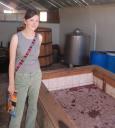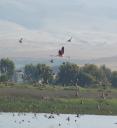Land of Pisco
April 20th, 2009Arriving at a bus terminal at night is inevitably a bad start to visiting a new city. In Moquegua, this was compounded by a plaza of protesters blaring their message over loud speakers, an hour-long search for a decent and reasonable hotel room, and a taxi-ride to a suburb where the 3 specialty restaurants were all closed for the night at 8pm. Things started to look up when we settled for a pizzeria and looked at its pisco list. After a brief question, the host was discussing the virtues of Norvill pisco and cracked open a new bottle for us to make chilcanos.
Chilcano Recipe
- mix equal parts pisco and sprite (or kola real lemon-lime)
- garnish with a slice of lime
Pisco sours may be the national drink of Peru, but in Moquegua the simple chilcano is the mixed drink of choice. Drinking pisco straight is for drinking professionals who enjoy the burn (and despite what Adam’s Mom thinks we aren’t that bad.) Pisco sours are a tasty cocktail but overwhelm the flavor of the pisco and might as well be made with vodka. Chilcanos are the perfect balance tempering but still allowing the pisco’s aroma and flavor to dominate the drink. Tasting the pisco is crucial in this town which is home to 66 competing bodegas each producing at least 2 varieties of the spirit either blends or from specific grapes.
In daylight, the following morning, we started visiting bodegas along the “Ruta del Pisco.” We walked to the 1st and oldest bodega in town, only a few blocks from the main plaza and after persistent banging on the door were rewarded with a genial tour and tastings of their pisco, cognac and port (which we hear is recommended for pregnant women). They were very happy to learn that we had tried their pisco at the pizzeria the night before. To visit another bodega, we hopped in a taxi and it all went uphill from there as our friendly driver extolled the virtues of Moquegua’s avocados, honey, piscos, and fried guinea pig.
Two bodegas later, as we waited for our lunch (and Cara said a prayer for a previous beloved pet), we delayed our imminent departure by another night much to the pleasure of our taxi turned private car driver. The goal of our afternoon was to visit Biondi, the most reknowned distiller in Peru yet still a rather small operation. The highlight was sitting around a picnic table with the owner of Bodega Zapata and his friends where we joined in their after lunch drink and chatted about pisco, politics, and peaceful Moquegua.
The next morning, we managed to move on to Chile whose national drink is also the pisco sour.




















